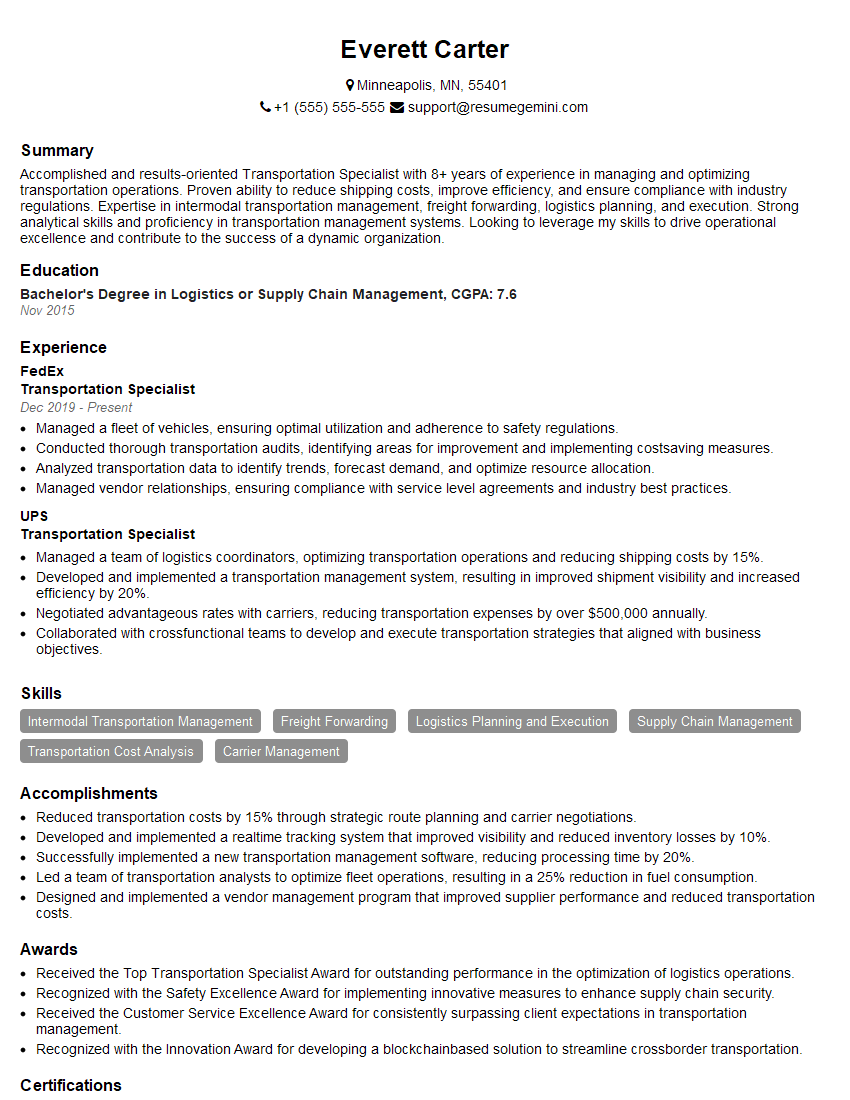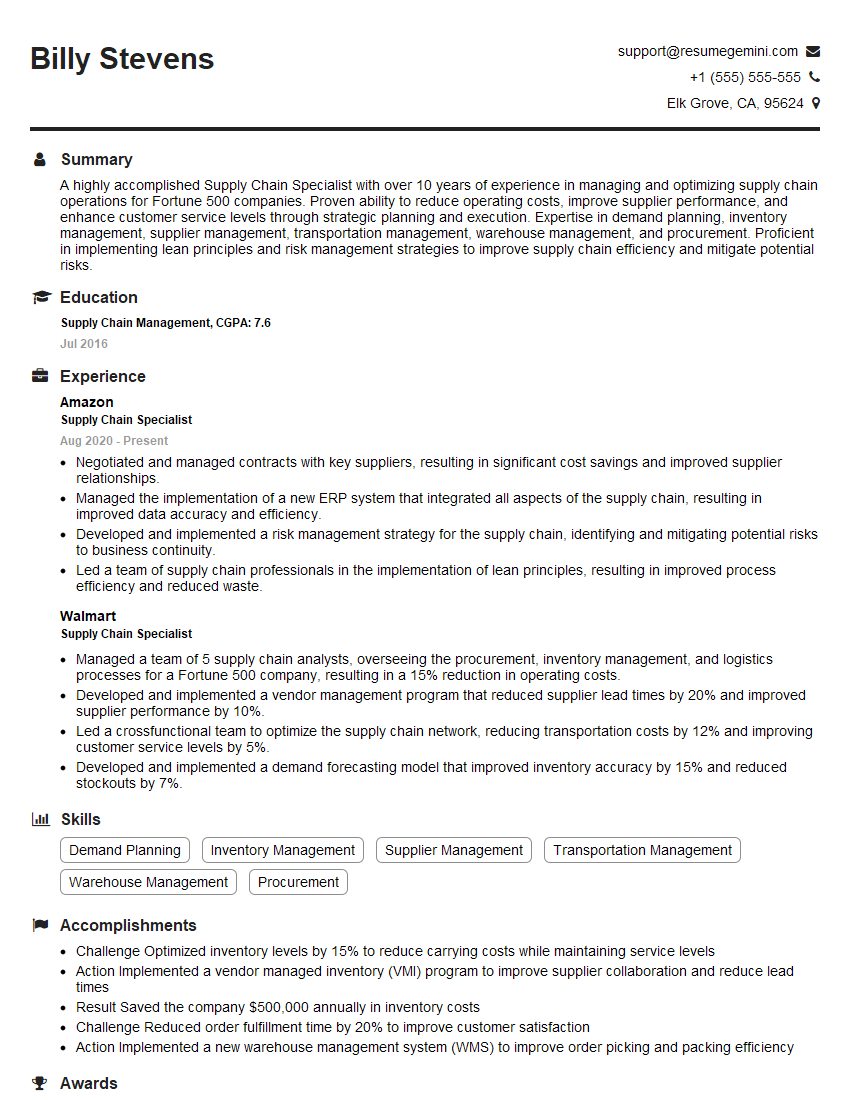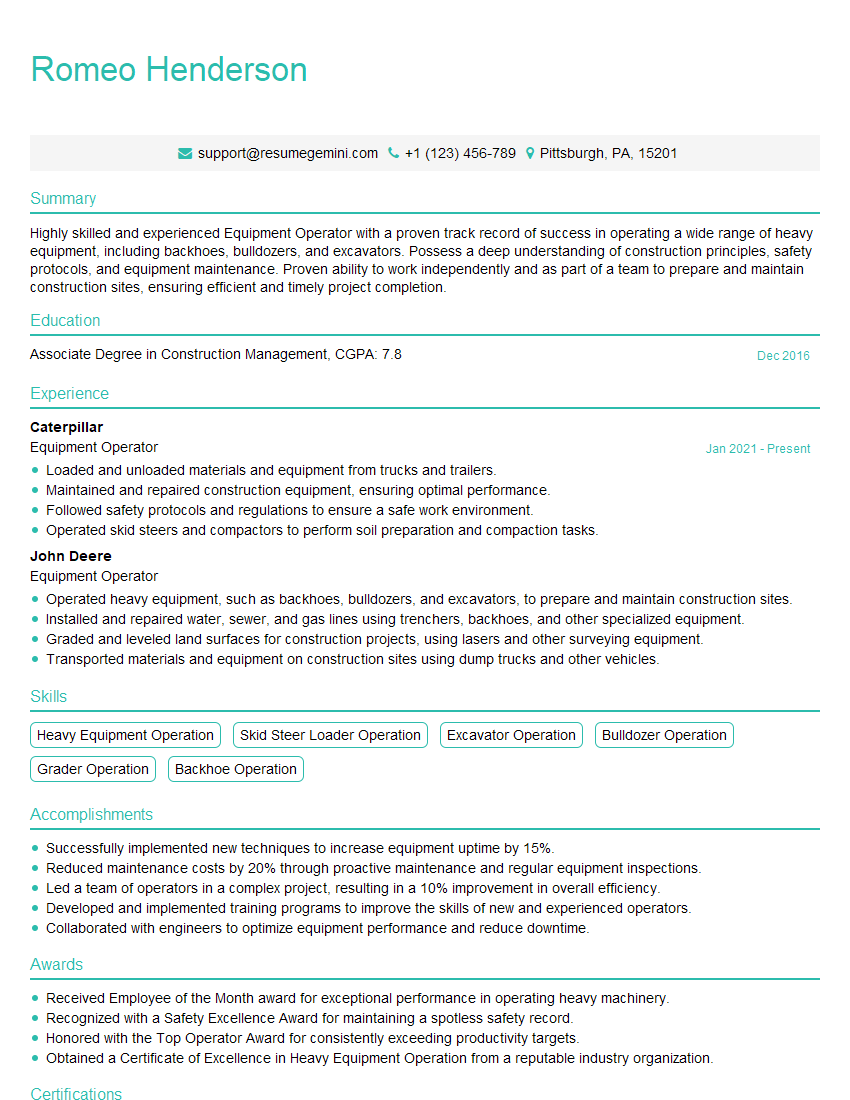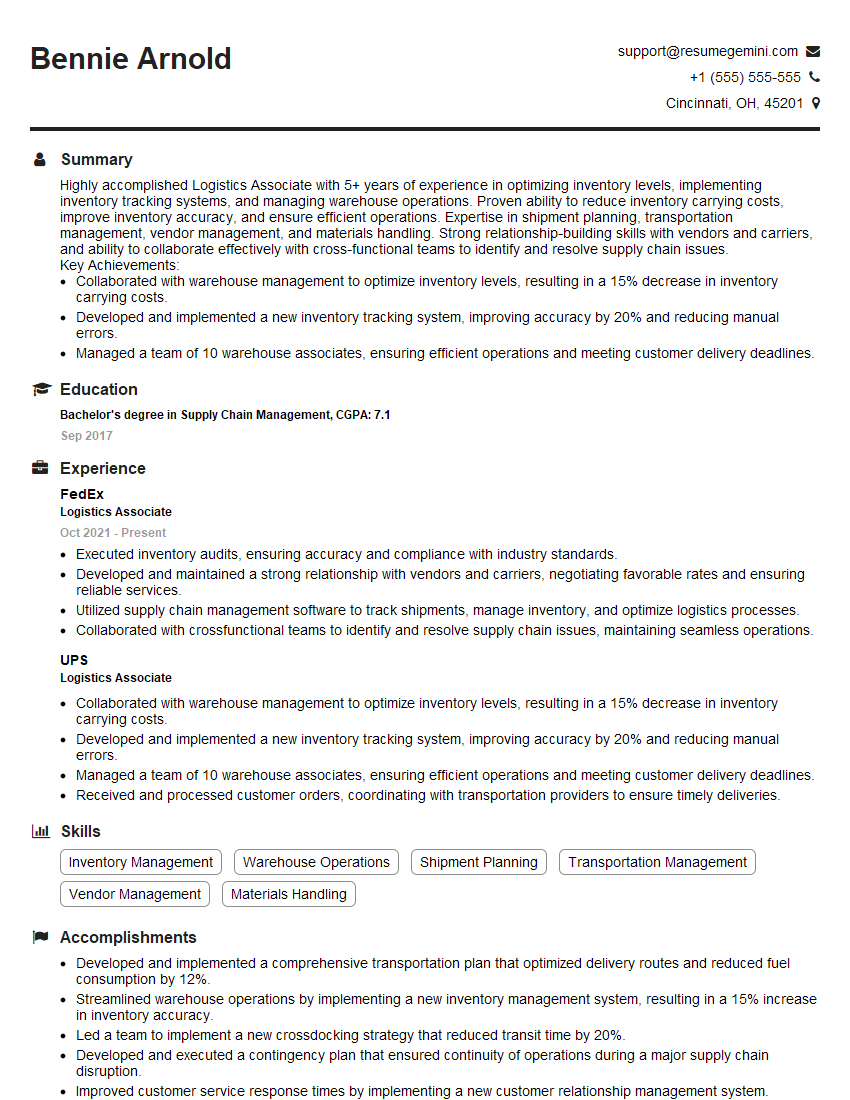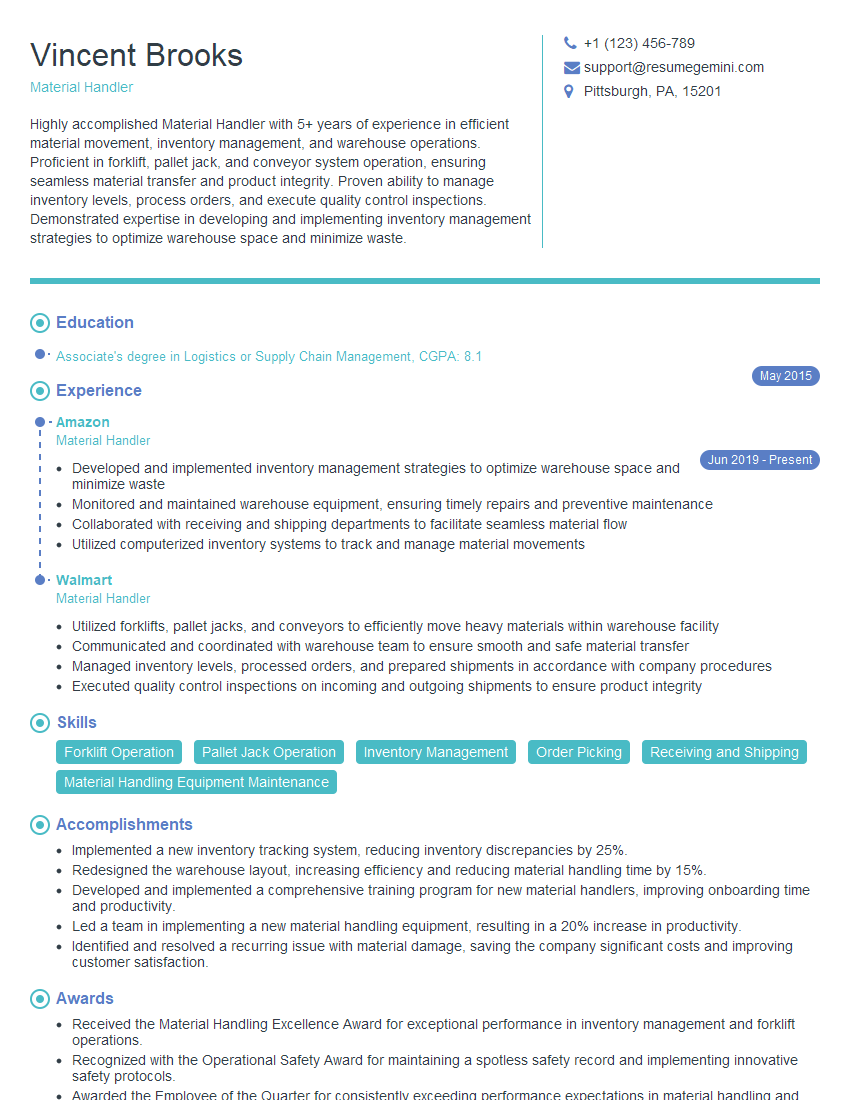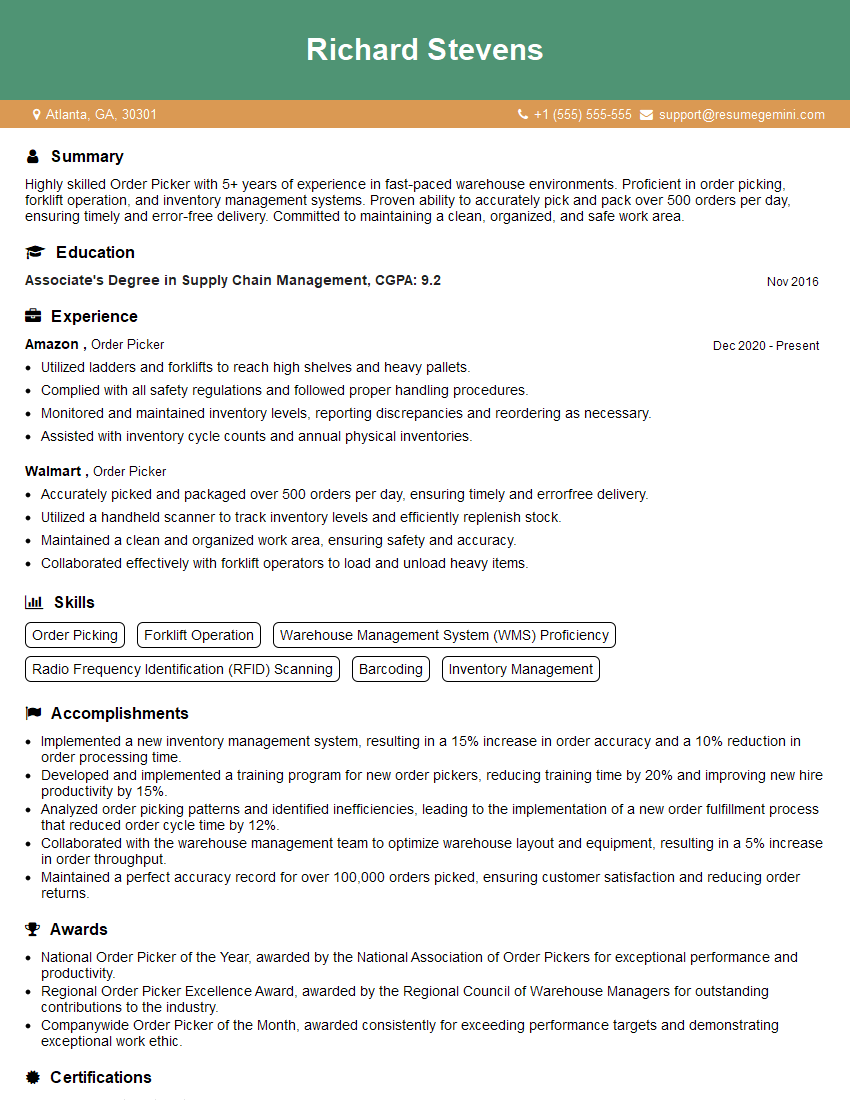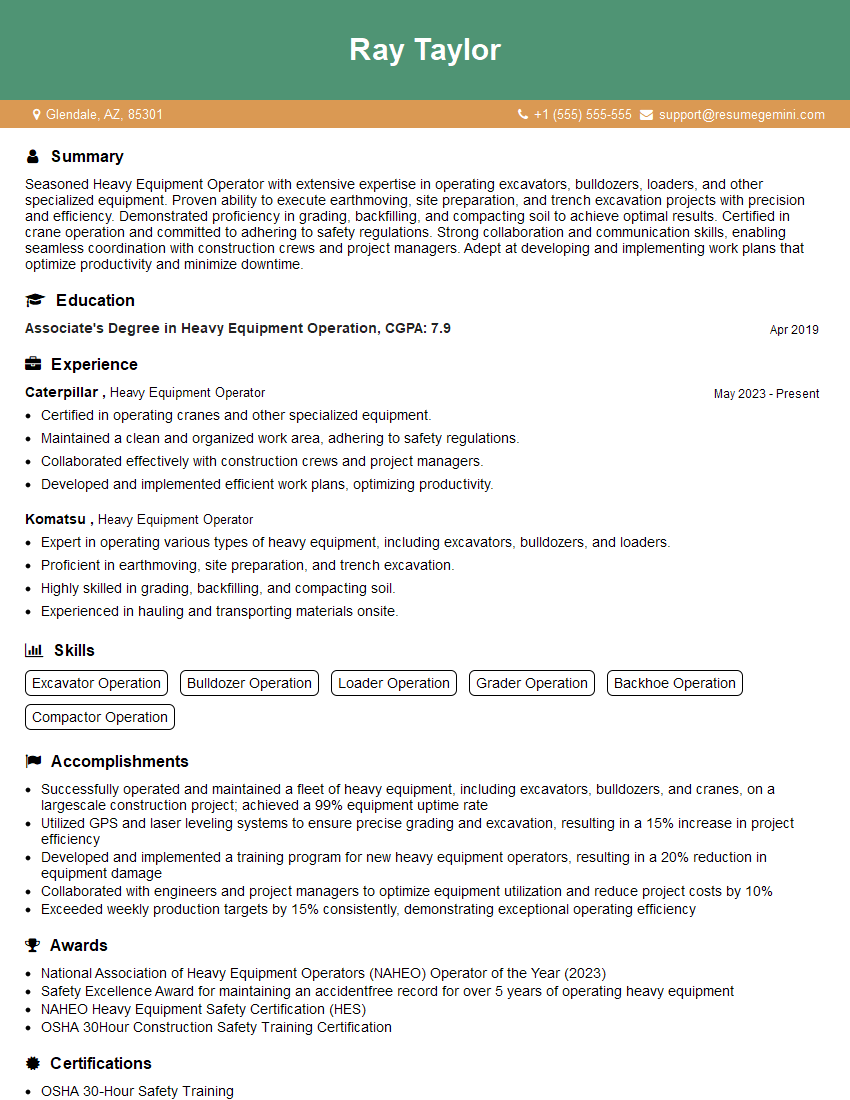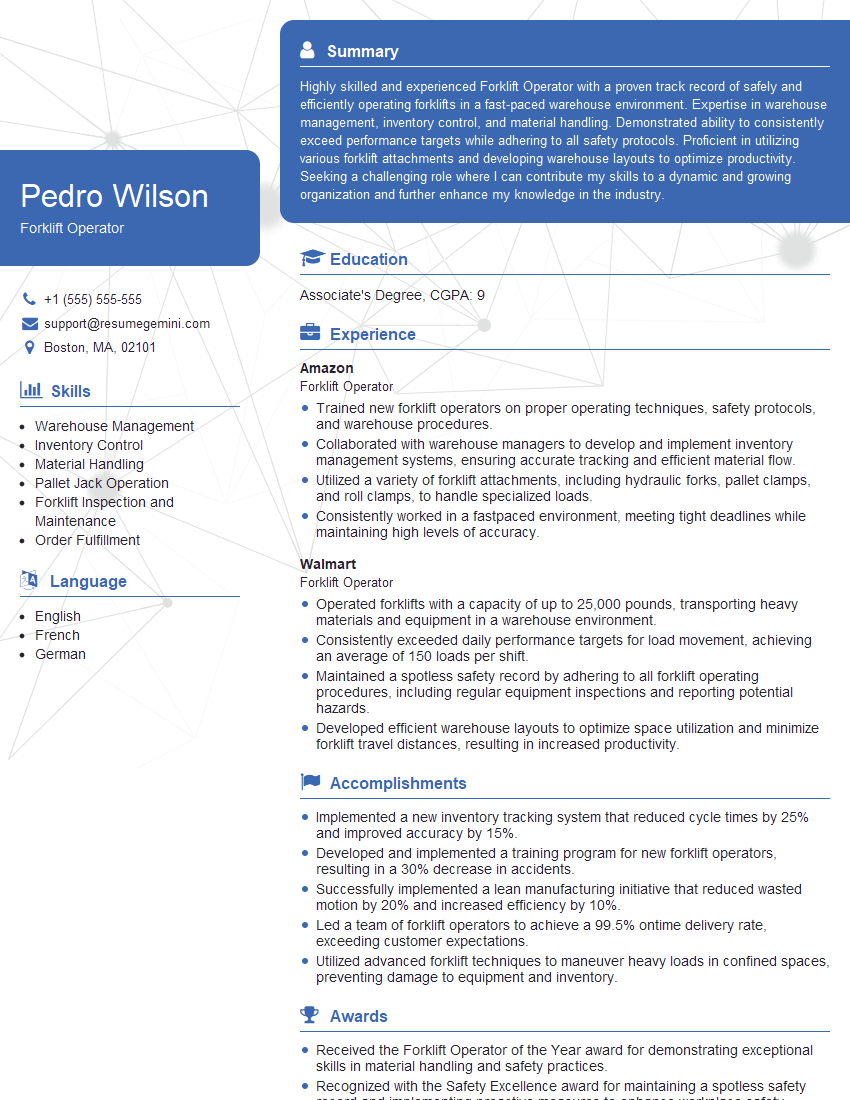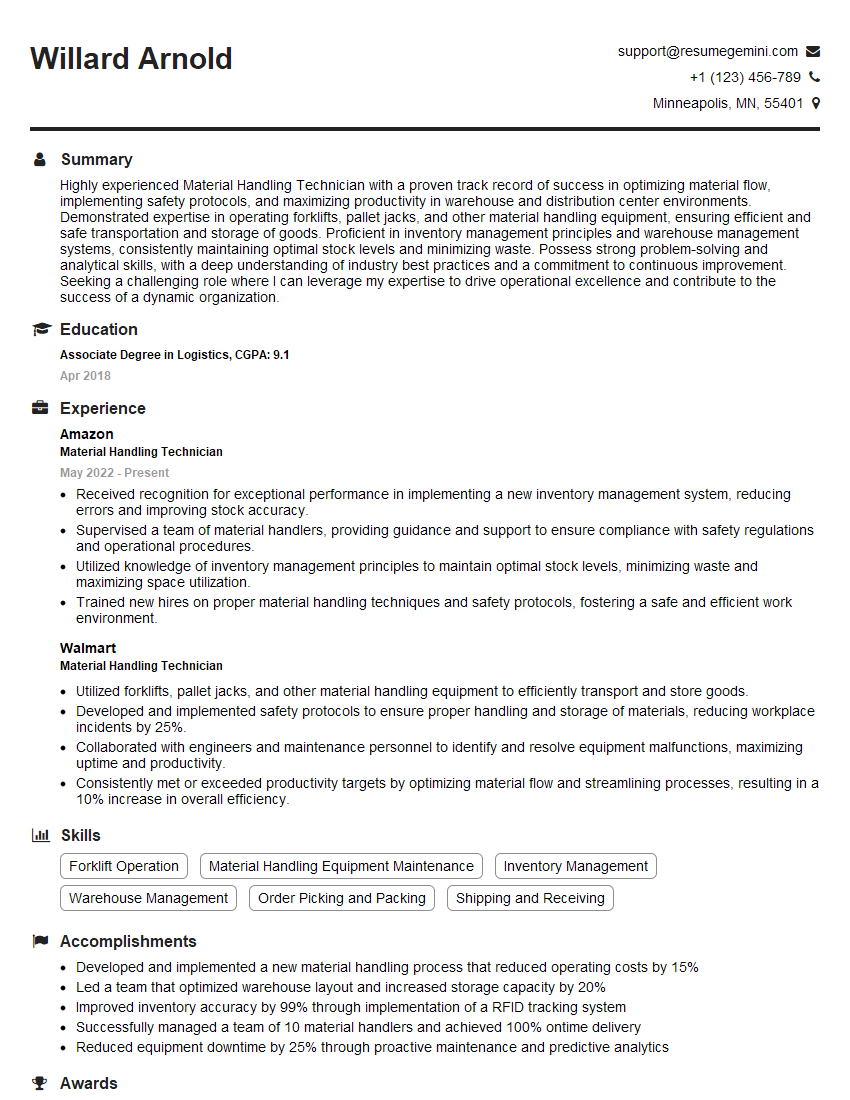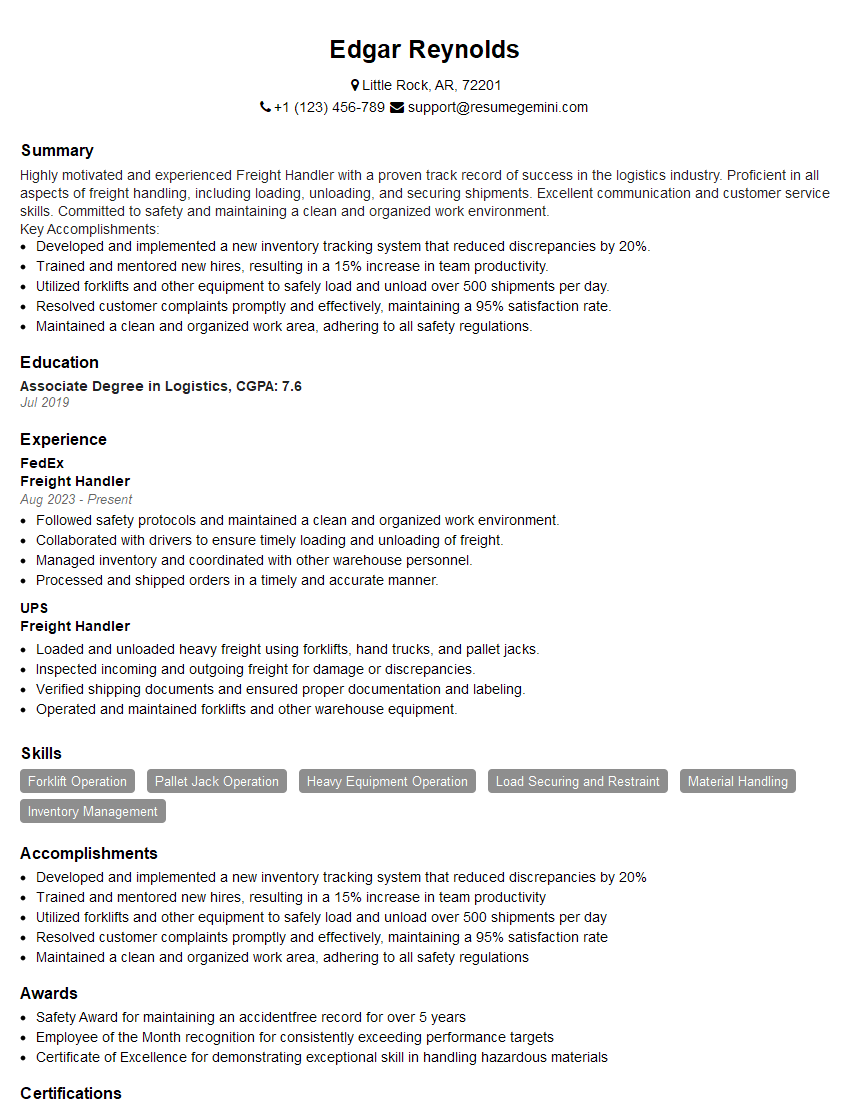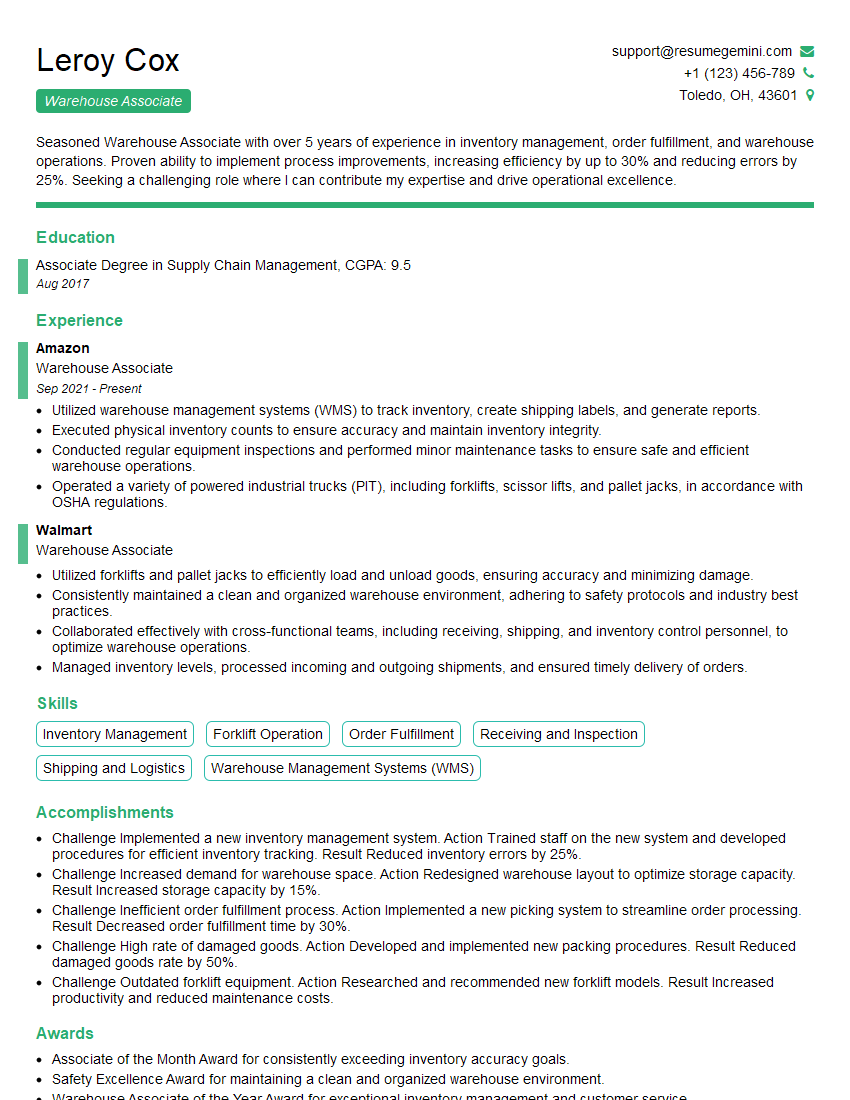Unlock your full potential by mastering the most common Dolly and Track Operation interview questions. This blog offers a deep dive into the critical topics, ensuring you’re not only prepared to answer but to excel. With these insights, you’ll approach your interview with clarity and confidence.
Questions Asked in Dolly and Track Operation Interview
Q 1. Explain the safe operating procedures for a hand dolly.
Safe operation of a hand dolly hinges on understanding its limitations and employing consistent safety practices. Think of it like driving a small car – you need to be aware of your surroundings and handle it carefully.
- Assess the load: Before even touching the dolly, carefully estimate the weight and ensure it’s within the dolly’s weight capacity. Overloading is a major hazard.
- Proper Lifting Techniques: Use your legs, not your back, to lift the load onto the dolly. Keep your back straight and bend at your knees. Get help for heavy or awkward items.
- Secure the Load: Use straps, ropes, or other securing devices to prevent the load from shifting during transport. Imagine a stack of boxes – you wouldn’t want them to topple over mid-move.
- Controlled Movement: Move slowly and deliberately. Avoid sudden stops or starts. Keep a firm grip on the dolly’s handle.
- Clear Path: Ensure a clear and unobstructed path before moving. Watch out for obstacles, uneven surfaces, and other people.
- Awareness of Surroundings: Be aware of your surroundings at all times. Pay attention to doorways, corners, and other potential hazards.
- Proper Footwear: Wear sturdy, closed-toe shoes with good traction to maintain balance and prevent slips.
For example, if I’m moving a heavy filing cabinet, I’d first assess its weight, ensure it’s within the dolly’s capacity, then carefully lift it using proper lifting techniques, secure it with straps, and move slowly, checking my path for obstructions.
Q 2. Describe the different types of dollies and their applications.
Dollies come in various types, each suited for specific applications. Think of it like choosing the right tool for a job – a screwdriver for screws, a hammer for nails.
- Hand Truck/Two-Wheel Dolly: The most common type, ideal for moving boxes, furniture, and other relatively lightweight items. It’s simple and versatile, but has limited maneuverability in tight spaces.
- Four-Wheel Dolly/Platform Dolly: Provides greater stability and maneuverability than a two-wheel dolly, making it suitable for heavier and bulkier loads. These are excellent for warehouses or large spaces.
- Appliance Dolly: Specifically designed for moving large appliances like refrigerators and washing machines. They often feature straps and specialized features for secure transport. These are essential in appliance delivery and moving.
- Furniture Dolly: Similar to an appliance dolly but with features specifically tailored to protect furniture during movement. Cushioned surfaces and straps are common.
- Heavy-Duty Dollies: Built to withstand extremely heavy loads. These are often found in industrial settings or construction sites.
For instance, I’d use a hand truck for moving boxes in an office, but opt for a four-wheel dolly for larger furniture in a home move. Heavy-duty dollies are essential in a warehouse environment where pallet jacks are not suitable for the task.
Q 3. How do you assess the weight of a load before moving it with a dolly?
Accurately assessing load weight is crucial for safety. Underestimating can lead to accidents, while overestimating might lead to unnecessary effort. There are several ways to do this:
- Visual Inspection: For familiar items, you can often estimate weight based on experience. A box of books weighs differently from a box of pillows, even if they’re the same size.
- Weighing Scales: For heavier or unknown items, using a weighing scale provides an accurate measurement. This is the most reliable method.
- Manufacturer Specifications: Some items may have weight information printed on them or readily available online. Check labels or manuals.
- Lifting Attempt (Caution): As a last resort, you can try lifting the item slightly to get a feel for its weight. If it feels too heavy, don’t attempt to move it alone.
If I’m unsure, I’ll always prioritize using a weighing scale to avoid any risks. I’d rather err on the side of caution and get assistance if the weight exceeds my safe lifting limits.
Q 4. What safety precautions do you take when maneuvering a dolly in tight spaces?
Maneuvering a dolly in tight spaces demands extra care. It’s like navigating a crowded street – slow down and be aware of your surroundings.
- Small, Controlled Movements: Make small, incremental movements, constantly checking your surroundings for obstacles.
- Pivot Turns: Use pivot turns instead of wide swings to avoid collisions. These are more precise for confined spaces.
- Additional Help: If the space is extremely tight or the load is heavy, having another person assist in guiding the dolly can improve safety and maneuverability.
- Assess Space: Before you start, thoroughly assess the space you need to navigate. Measure the doorway or passage if necessary to ensure the dolly will fit.
- Use Mirrors (If Applicable): If visibility is limited, use mirrors or have a spotter to ensure a safe path.
For example, when moving furniture through a narrow hallway, I’d use a four-wheel dolly and use pivot turns instead of swinging the dolly widely. If necessary, I would have another person guide the dolly to ensure it clears the corners and walls safely.
Q 5. Describe your experience with different types of tracks (e.g., conveyor belts, roller tracks).
My experience encompasses various track systems, each with its unique characteristics and applications. Think of them as different roads for different types of traffic.
- Conveyor Belts: I’ve worked extensively with conveyor belts in various industrial settings. They are effective for moving items over long distances, particularly in automated systems. Maintenance and safety protocols, like regular inspections for wear and tear, are crucial. I’ve had experience troubleshooting belt alignment and speed issues.
- Roller Tracks: Roller tracks are more suitable for moving heavier items across shorter distances. They’re less complex than conveyor belts, offering simplicity in manual operations. I’ve used these in warehouses and manufacturing environments. The key is ensuring the rollers are clean and lubricated for smooth operation.
- Gravity Tracks: These rely on gravity to move items, and are ideal for incline transport. Safety features like brakes and speed control are vital for accident prevention. I’ve worked with systems that used gravity tracks in combination with other systems for efficient movement of material.
My experience allows me to adapt to different track systems and to effectively troubleshoot and maintain them. Each system requires a different set of safety procedures and maintenance practices.
Q 6. How do you ensure the stability of a load while using a dolly or track system?
Maintaining load stability is paramount for safe dolly and track operations. Think of it like building a sturdy structure – every component needs to be secure.
- Proper Securing: Use straps, ropes, or other appropriate securing devices to prevent shifting or tipping. The load must be firmly attached to the dolly or track.
- Weight Distribution: Distribute the weight evenly across the dolly or track system. Avoid concentrating weight in one area.
- Load Centering: Center the load on the dolly or track to maintain balance and prevent tipping. An uneven distribution of weight can easily cause accidents.
- Regular Inspection: Regularly inspect the dolly or track for any signs of damage or wear that could compromise stability.
- Appropriate Equipment: Use the correct type of dolly or track system for the specific load. Don’t try to force a small dolly to carry something too heavy.
For example, when moving a heavy refrigerator using a dolly, I’d ensure it’s centered and secured tightly with straps to prevent it from shifting during transit. Similarly, when using a conveyor belt, I’d monitor the flow of items to ensure they don’t bunch up and create instability.
Q 7. What are the common causes of accidents involving dollies and tracks, and how can they be prevented?
Accidents involving dollies and tracks stem from various causes, most stemming from negligence or a lack of awareness. Prevention focuses on training and consistent safety practices.
- Overloading: Exceeding the weight capacity of the dolly or track is a major cause of accidents. Always check weight limits and use appropriate equipment.
- Improper Securing: Loads not properly secured can shift during movement, leading to tipping or falling. Use appropriate restraints and secure the load firmly.
- Uneven Surfaces: Uneven or slippery surfaces can cause loss of control, leading to accidents. Ensure the path is clear and level.
- Improper Lifting Techniques: Incorrect lifting techniques can lead to back injuries and dropped loads. Use proper lifting procedures to prevent injury.
- Lack of Training: Inadequate training on safe dolly and track operation increases the risk of accidents. Provide comprehensive safety training to all users.
- Poor Maintenance: Damaged dollies or tracks can cause accidents. Regular inspections and maintenance are vital.
Prevention involves thorough training, regular inspections, enforcing weight limits, and encouraging a safety-first culture. Implementing a checklist before each task can significantly reduce risk.
Q 8. How do you handle unexpected obstacles or challenges while operating a dolly or track system?
Unexpected obstacles during dolly or track operation require a calm and methodical approach. My first step is always safety – ensuring the immediate area is secure and no one is at risk. This might involve stopping the operation completely and alerting others in the vicinity.
For example, if I encounter a significant incline not accounted for in the plan, I would reassess the load weight and stability. I might need to adjust the dolly’s position, add additional securing measures, or even request assistance to move the load more safely. If I encounter an obstruction, like a misplaced pallet, I carefully navigate around it or, if necessary, remove the obstruction after confirming it’s safe to do so. Documentation of the obstacle and the corrective action taken is crucial for future reference and safety analysis.
Essentially, my approach involves assessment, adaptation, and documentation. Every situation is unique, and I prioritize safety above all else when dealing with the unforeseen.
Q 9. Explain your experience with load securing techniques.
Load securing is paramount for safety and preventing damage to goods. My experience encompasses various techniques depending on the load’s characteristics and the transportation method. This includes using straps, chains, and other securing devices to ensure the load remains stable during transport. I’m proficient in calculating appropriate tension and placement for optimal security.
For instance, when moving fragile items on a dolly, I might use padding and soft straps to prevent shifting or damage. Heavier items might require ratchet straps or chains secured to the dolly’s frame. I always consider the center of gravity of the load and ensure proper weight distribution to avoid tipping or instability. Regularly checking the securing mechanisms throughout the transport is vital to ensure ongoing security. I’ve also had experience with specialized load securing techniques, including using anti-slip mats and wedge blocks for particularly challenging loads.
Q 10. What is your experience with using different types of hand trucks?
I have extensive experience with various hand trucks, including two-wheel hand trucks, four-wheel hand trucks, stair climbers, and specialized hand trucks for handling specific materials like drums or heavy machinery. Knowing the capabilities and limitations of each type is critical. For example, two-wheel hand trucks are suitable for lighter loads on level surfaces but not ideal for stairs or uneven terrain, while stair climbers are designed specifically for navigating steps.
My selection depends on the load type, weight, distance, and terrain. I wouldn’t use a standard two-wheel hand truck to move a heavy pallet up a flight of stairs; a stair climber or a motorized hand truck would be more appropriate. Selecting the correct hand truck not only boosts efficiency but also significantly enhances safety, reducing the risk of injury or damage to the goods.
Q 11. Describe your process for inspecting a dolly before use.
Before each use, I conduct a thorough inspection of the dolly, paying attention to key components. This includes checking the wheels for proper inflation and wear, ensuring the frame is structurally sound with no cracks or damage, inspecting the bearings for smoothness, checking the condition of any straps or securing mechanisms for wear and tear, and confirming the stability of the platform.
I visually inspect for any loose bolts or parts and check the braking mechanism (if applicable) to ensure it functions correctly. If any defects are found, I immediately report them to my supervisor and take the dolly out of service. This pre-use inspection is a fundamental step in maintaining safety and preventing accidents.
Q 12. How do you maintain the safety and efficiency of a track system?
Maintaining safety and efficiency in a track system requires a multi-faceted approach. Regular inspections of the tracks are vital, checking for any wear, damage, or misalignment. Ensuring the tracks are properly lubricated (where applicable) helps reduce friction and maintain smooth operation. Keeping the area around the track system clean and free from obstructions prevents accidents and ensures efficient movement.
Proper training for operators is also crucial. Operators should be familiar with safe operating procedures, emergency shutdown protocols, and the correct handling of loads. Regular maintenance and timely repairs are essential to prevent malfunctions and downtime. This proactive approach helps to ensure the system operates safely and efficiently for extended periods.
Q 13. What are the signs of a malfunctioning dolly or track system?
Several signs indicate a malfunctioning dolly or track system. For dollies, these include squeaky or stiff wheels, wobbly frames, damaged platforms, or malfunctioning brakes. For track systems, uneven movement, unusual noises, visible damage to the track itself, or binding indicate potential problems.
Any resistance beyond normal operational resistance, unexplained noises (grinding, screeching), or excessive vibration are all potential warning signs requiring immediate attention. Ignoring these signs can lead to accidents and damage. Immediate investigation and repair or replacement are necessary to ensure continued safe operation.
Q 14. How do you report and document any incidents or accidents?
Reporting and documenting incidents or accidents is crucial for learning from mistakes and preventing future occurrences. My procedure involves immediately reporting the incident to my supervisor, providing a detailed account of what happened, the circumstances leading to the event, and any injuries or damages sustained. This report includes date, time, location, involved personnel, and a description of the incident.
I then complete an incident report form, providing further details, including any contributing factors, witness statements, and photos or videos if available. This documentation aids in identifying root causes, implementing corrective actions, and improving safety procedures. Following company protocols meticulously ensures all necessary steps are taken.
Q 15. Describe your experience working with different types of materials.
My experience encompasses handling a wide variety of materials, from delicate electronics requiring specialized packaging and handling to heavy pallets of raw materials demanding the use of forklifts and pallet jacks. I’m familiar with the unique characteristics of different materials, including their weight, fragility, dimensions, and storage requirements. For instance, I’ve worked extensively with palletized goods, requiring careful stacking and securing to prevent damage during transport. I’ve also handled loose items, necessitating meticulous organization and inventory control to prevent mix-ups or losses. Experience with oversized or awkwardly shaped items has honed my skills in securing loads and using appropriate equipment for safe and efficient movement. My understanding extends to hazardous materials, where I’ve adhered strictly to safety protocols, including proper labeling, storage, and handling procedures.
Career Expert Tips:
- Ace those interviews! Prepare effectively by reviewing the Top 50 Most Common Interview Questions on ResumeGemini.
- Navigate your job search with confidence! Explore a wide range of Career Tips on ResumeGemini. Learn about common challenges and recommendations to overcome them.
- Craft the perfect resume! Master the Art of Resume Writing with ResumeGemini’s guide. Showcase your unique qualifications and achievements effectively.
- Don’t miss out on holiday savings! Build your dream resume with ResumeGemini’s ATS optimized templates.
Q 16. How do you prioritize tasks when multiple items need to be moved?
Prioritizing tasks in a busy warehouse setting is crucial for efficiency and meeting deadlines. My approach uses a combination of factors, starting with urgency. Time-sensitive orders, those with imminent delivery deadlines, take precedence. Next, I consider order size and material type. Large, complex orders might need more time and resources, influencing their position in the queue. Fragile items will be handled earlier to minimize the risk of damage. I also prioritize tasks based on location. Grouping tasks that are geographically closer together minimizes travel time and improves overall efficiency. Finally, I often utilize warehouse management systems (WMS) which help in prioritizing based on factors such as order picking sequence or storage location.
For example, if I have an urgent order for a small quantity of fragile electronics and a larger order of less sensitive materials with a later delivery deadline, I’d prioritize the electronics order first, ensuring their safe handling. This structured approach allows for optimal workflow and prevents bottlenecks.
Q 17. Explain your understanding of warehouse safety regulations.
Warehouse safety is paramount, and my understanding of regulations is comprehensive. This includes familiarity with OSHA guidelines and company-specific safety protocols. Key aspects include proper forklift operation, which involves regular inspections, adherence to speed limits, and safe load handling. I’m knowledgeable about the use of Personal Protective Equipment (PPE), such as safety shoes, gloves, and high-visibility vests, depending on the task and material being handled. Maintaining a clean and organized workspace is essential to prevent accidents, so I’m diligent about putting items away in their designated locations and ensuring walkways remain clear. Proper fire safety procedures, including the location of fire extinguishers and emergency exits, are second nature. Furthermore, I understand the importance of reporting any accidents or near misses immediately to ensure swift action and prevent recurrence.
Q 18. How do you adapt your techniques to different work environments?
Adaptability is crucial in warehouse environments, where layouts, equipment, and material types can vary significantly. I easily adjust my techniques to accommodate diverse workspaces. For example, I’m proficient in using various types of forklifts, pallet jacks, and other material handling equipment, ensuring I can efficiently navigate different warehouse configurations. I quickly learn new inventory management systems and adapt my workflow to the specific requirements of each system. I also understand how to adjust my approach based on the characteristics of the materials being moved. Handling delicate electronics in a climate-controlled facility requires a different approach compared to moving heavy pallets outdoors. Communication is key; I actively seek clarification from supervisors or colleagues if I encounter unfamiliar procedures or equipment.
Q 19. What is your experience with using inventory management systems?
I have extensive experience using various inventory management systems (IMS), including both standalone software and integrated WMS solutions. My skills encompass data entry, order fulfillment, stock tracking, and reporting. I’m proficient in using scanners for accurate item identification and location tracking. I understand the importance of maintaining data integrity within the system, ensuring accurate stock levels and avoiding discrepancies. I’m familiar with generating reports on inventory levels, order status, and other key metrics, aiding in inventory control and decision-making. For instance, using a WMS to optimize picking routes significantly improves efficiency, reducing travel time and increasing throughput. I am comfortable learning and adapting to new IMS platforms.
Q 20. Describe your experience with teamwork in a warehouse setting.
Teamwork is essential in warehouse operations. I value collaboration and open communication, ensuring tasks are completed efficiently and safely. In my experience, I’ve worked effectively in teams, assisting colleagues, sharing knowledge, and supporting each other during peak periods. For example, during a rush order, I’ve collaborated with colleagues to efficiently organize tasks, splitting the workload effectively to meet the deadline. I’m comfortable receiving and providing constructive feedback, contributing to a positive and productive team environment. I believe in a supportive team dynamic where everyone feels valued and contributes to success.
Q 21. How do you handle stressful situations or high-pressure environments?
High-pressure situations are common in warehousing, particularly during peak seasons or when dealing with urgent orders. I approach these situations calmly and methodically, prioritizing tasks effectively to avoid feeling overwhelmed. My organizational skills and experience with various inventory management systems allow me to maintain composure and efficiency. I focus on clear communication with my team and supervisor to ensure everyone is aware of the situation and working towards a common goal. Deep breaths, taking short breaks when possible, and maintaining a positive attitude help me manage stress levels effectively. For example, during a significant backlog, I’ve successfully coordinated with my team to prioritize and complete the orders, avoiding errors and meeting deadlines by utilizing a systematic approach and clear communication.
Q 22. What is your understanding of ergonomics and how does it apply to dolly and track operation?
Ergonomics is the science of designing the workplace to fit the worker, reducing strain and improving efficiency. In dolly and track operation, this means considering factors like the weight of loads, the height of the work surface, the distance of transport, and the posture of the operator. Poor ergonomics can lead to musculoskeletal disorders like back pain and carpal tunnel syndrome.
For example, using a dolly with adjustable handles allows operators of different heights to maintain a comfortable posture. Choosing dollies with swivel casters helps reduce the strain on wrists during turns. Proper training emphasizes lifting techniques (bending knees, lifting with legs, keeping the load close to the body) to minimize back injuries. We also need to consider the design of the tracks; uneven surfaces or poorly maintained tracks can cause excessive strain.
Q 23. Explain your experience with load balancing and weight distribution.
Load balancing and weight distribution are crucial for safe and efficient dolly and track operation. It’s about distributing the weight evenly across the dolly to prevent tipping and stress on the wheels and frame. I’ve consistently utilized techniques like carefully positioning heavier items towards the center of gravity and using tie-downs or straps to secure large or oddly shaped items.
For instance, when moving a pallet of bricks, I’d make sure the bricks are stacked evenly and the pallet is centered on the dolly. For exceptionally heavy loads, I’d consider using multiple dollies or a heavier-duty model designed for that capacity. I’ve also worked with teams to coordinate the distribution of weight across multiple dollies to move oversized or exceptionally heavy pieces of equipment in a coordinated manner.
Q 24. How do you ensure efficient movement of goods through the warehouse using dollies and tracks?
Efficient movement of goods relies on several factors. Firstly, optimizing the layout of the warehouse to minimize travel distances is key. This includes strategic placement of receiving and shipping docks, as well as the storage areas. Second, clear pathways and well-maintained tracks prevent congestion and potential accidents. Third, utilizing appropriate dollies – e.g., heavy-duty dollies for heavier items or platform dollies for larger, bulkier loads – is vital. Finally, clear communication and teamwork ensure smooth flow of movement. In one particular warehouse, we implemented a color-coded system for pathways that indicated the flow of goods, considerably improving efficiency.
Furthermore, regular maintenance of dollies and tracks is vital for preventing breakdowns and delays. We implemented a daily checklist for dolly inspections which identified minor problems such as wheel damage before they developed into major issues.
Q 25. What are the different types of damage that can occur to goods during handling, and how to prevent them?
Goods can be damaged during handling in various ways, including scratches, dents, breakage, and crushing. Prevention involves careful handling, proper packaging, and secure fastening. Scratches and dents can be avoided by using padding and protective coverings. Breakage can be minimized using appropriate packaging materials and ensuring that fragile items are clearly labeled and handled with extra care. Crushing is prevented by proper weight distribution on the dolly and avoiding overloading.
For example, I’ve witnessed damage to glass products when improperly stacked, which is why we now use dividers during transport. Similarly, we instituted training on proper wrapping and securing techniques to prevent product damage during transit. Clear communication with receiving and shipping dock personnel is critical to avoid handling damage during the transfer process.
Q 26. Describe your experience using any specialized equipment associated with dolly or track operation.
My experience includes using a variety of specialized equipment including powered dollies, which are especially helpful with heavier loads. I’ve also used conveyor systems in conjunction with dollies for transferring goods between levels. The conveyor systems greatly improved efficiency and reduced strain on operators in those situations. Another example is specialized dollies with different attachments, such as those with ramps to load heavier equipment.
In one project, we used a custom-designed dolly with a rotating platform to transport large, heavy pieces of machinery that required precise maneuvering. I was responsible for ensuring the platform was properly balanced and secured before each move. My experience with these technologies underscores the value of adapting equipment to the specific needs of the task.
Q 27. How would you handle a situation where a dolly malfunctions during a critical operation?
If a dolly malfunctions during a critical operation, my immediate response would be to prioritize safety. I’d first assess the situation, determining if there is any immediate danger to personnel or the goods. I would then immediately stop the operation. Depending on the nature of the malfunction, I’d either attempt a temporary fix (if safe and feasible) or immediately request a replacement dolly. If the problem is minor and quick to resolve, I would do so, documenting the repair. Otherwise, I would immediately inform my supervisor and arrange for a replacement dolly.
The safety of personnel and the prevention of further damage would be paramount; this includes a thorough inspection of the load to assess any potential damage prior to securing it on a replacement dolly. Accurate documentation of the incident, including the type of malfunction and any damage sustained, is crucial for preventative maintenance.
Key Topics to Learn for Dolly and Track Operation Interview
- Safety Procedures and Regulations: Understanding and applying relevant safety protocols for dolly and track operations, including load securing techniques and emergency procedures.
- Equipment Operation and Maintenance: Practical knowledge of operating various types of dollies and tracks, including pre-operation checks, routine maintenance, and troubleshooting common issues.
- Load Handling and Transportation: Mastering techniques for safe and efficient loading, transporting, and unloading of materials using dollies and tracks, considering weight distribution and stability.
- Spatial Reasoning and Planning: Developing skills in visualizing and planning efficient movement of materials within confined spaces, optimizing routes and minimizing risks.
- Teamwork and Communication: Understanding the importance of effective communication and collaboration with colleagues to ensure safe and coordinated operations.
- Problem-Solving and Troubleshooting: Developing the ability to identify and resolve issues that may arise during dolly and track operations, including mechanical malfunctions and logistical challenges.
- Relevant Industry Standards and Best Practices: Familiarizing yourself with industry-specific standards and best practices related to dolly and track operations, ensuring compliance and safety.
Next Steps
Mastering Dolly and Track Operation opens doors to diverse roles within logistics, manufacturing, and warehousing, offering excellent career progression opportunities. To significantly boost your job prospects, creating an Applicant Tracking System (ATS)-friendly resume is crucial. ResumeGemini is a trusted resource that can help you build a professional and impactful resume, tailored to highlight your Dolly and Track Operation skills. Examples of resumes specifically designed for this field are available to help you craft a winning application.
Explore more articles
Users Rating of Our Blogs
Share Your Experience
We value your feedback! Please rate our content and share your thoughts (optional).
What Readers Say About Our Blog
good





